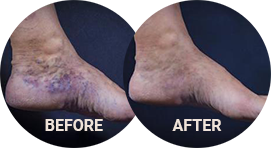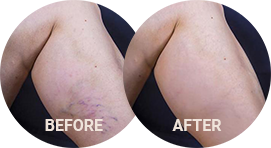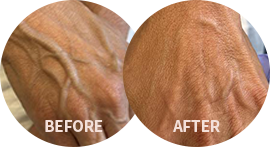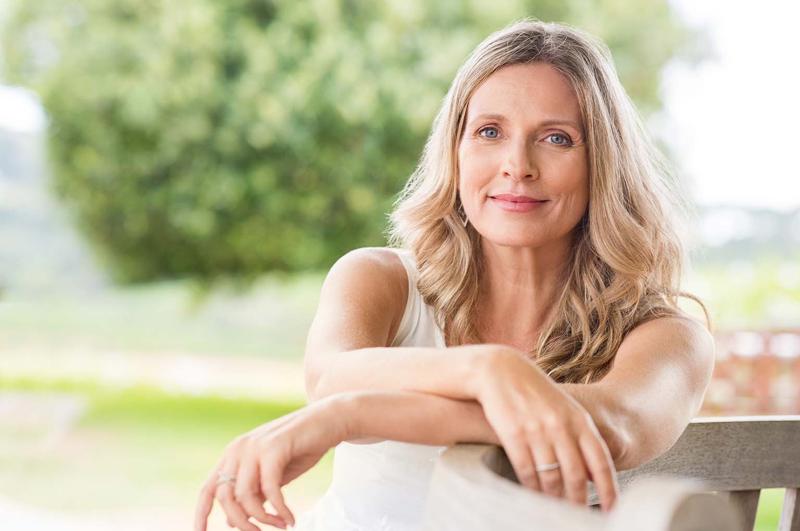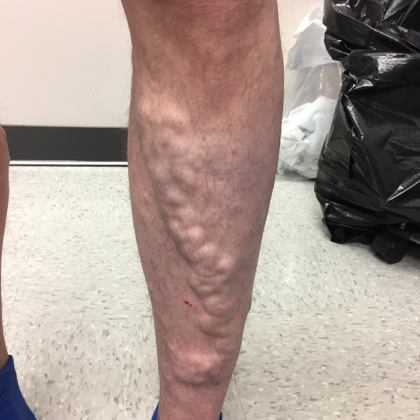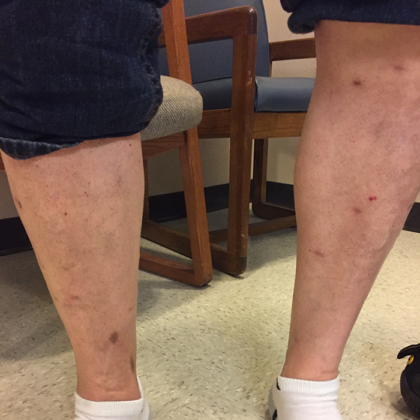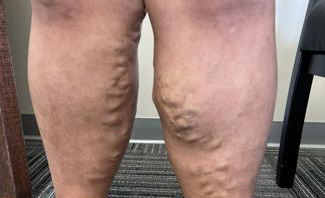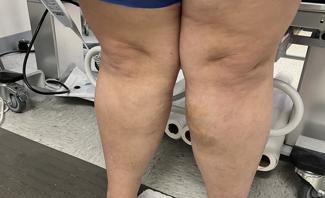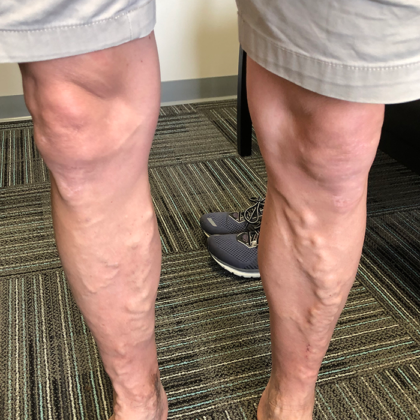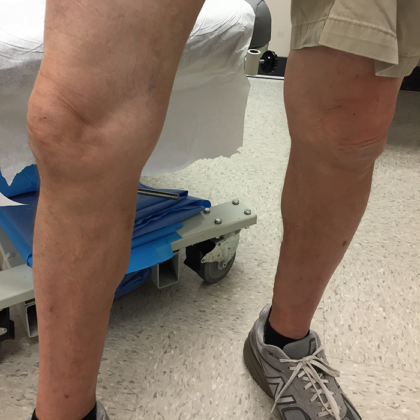Prompt treatment of varicose veins is essential for a variety of cosmetic and medical reasons. Untreated varicose veins can lead to a cascade of complications that not only affect the appearance of the legs but also pose potential risks to overall health and well-being. There are several stages of varicose vein development, which can cause unsightly, twisted venous formations that can impact self-esteem and confidence. Treating them can improve the appearance of the legs, enhancing self-image and psychological well-being.
Severe varicose veins may limit mobility and activity due to pain and discomfort. They may even cause more serious complications such as skin ulcers, blood clots, and superficial thrombophlebitis (inflammation). That is why patients should seek treatment for their varicose veins from an experienced vascular surgeon.
Addressing varicose veins early with appropriate medical intervention, such as minimally invasive treatments offered at Premier Vein Clinic, can help prevent potential complications and improve both the cosmetic appearance and the overall health of your legs. Under the expertise of Dr. David Naar, patients can act promptly to safeguard their vascular health and enhance their quality of life. Call (440) 641-0433 or fill out a form to get started with varicose vein treatment in Westlake, OH.
Contents
Before and After Photos
What Are Varicose Veins?
When blood flow is compromised, either due to weakened vein walls or malfunctioning valves, it can lead to varicose veins. These enlarged, twisted veins are often associated with discomfort or cosmetic concerns. They are 3mm (0.12 in) or greater in diameter and blueish-purple in color, appearing most frequently in the legs. (1)
Symptoms associated with untreated varicose veins can manifest in the form of pain, swelling, cramps, and changes in the skin. The discomfort may range from aching and throbbing to a feeling of heaviness in the affected area. Additionally, the skin over varicose veins may become discolored, dry, or itchy, signaling underlying vascular issues that warrant attention.
Venous Insufficiency
The role of vein valves is crucial in maintaining healthy blood flow. When these valves weaken or become damaged, blood can pool in the veins, contributing to the development of varicose veins. This is known as venous insufficiency.
CEAP Classification
CEAP stands for Clinical (C), Etiological (E), Anatomical (A), and Pathophysiological (P). (2) Vascular surgeons use the following classifications to describe the progression of venous disease.
- C0 Non-visible or palpable signs of venous disease
- C1 Telangiectasias or reticular veins
- C2 Varicose veins
- C2r Recurrent varicose veins
- C3 Edema
- C4 Changes in skin and subcutaneous tissue secondary to chronic venous disease
- C4a Pigmentation or eczema
- C4b Lipodermatosclerosis or atrophie blanche
- C4c Corona phlebectatica
- C5 Healed venous ulcer
- C6 Active venous ulcer
- C6r Recurrent active venous ulcer
Who is More Likely to Have Varicose Veins?
You are more likely to have varicose veins if: (3)
- You are over the age of 60
- You are a woman
- Someone in your family has varicose veins
- You have a BMI over 30
- You spend long periods sitting or standing
Varicose veins can impact one’s self-confidence and body image, leading to feelings of insecurity and self-consciousness. They can also significantly impact a person’s day-to-day life in various ways.
Symptoms of Untreated Varicose Veins
Leg Pain
Pain related to untreated varicose veins can vary from mild to severe, impacting daily activities and diminishing quality of life. Discomfort may worsen after prolonged standing or sitting, highlighting the need for timely management to alleviate symptoms and prevent further complications.
Swelling
Swelling is another common consequence of neglected varicose veins. Fluid accumulation in the tissues surrounding affected veins can result in edema, leading to discomfort and reduced mobility. Swollen legs and ankles may not only be unsightly but also indicative of an underlying venous insufficiency that requires medical evaluation.
Skin Changes
Skin changes, such as hyperpigmentation, eczema, and stasis dermatitis, may occur in untreated varicose veins due to compromised circulation and tissue oxygenation. These alterations in skin texture and color serve as visual indicators of underlying venous insufficiency, prompting the need for comprehensive evaluation and treatment.
Venous Ulcers
Ulcers, or open sores on the skin, can develop as a result of untreated varicose veins. Poor circulation and increased pressure in affected veins can impair skin healing, predisposing individuals to ulcer formation. Proper wound care and vascular treatment are essential to prevent complications and promote healing.
Blood Clots
The risk of blood clots, or deep vein thrombosis, is heightened in individuals with untreated varicose veins. Reduced blood flow and venous pooling create an environment conducive to clot formation, posing a serious threat to cardiovascular health. Timely intervention is crucial to mitigate this risk and safeguard overall well-being.
Personal Consultation
At Premier Vein Clinic under the expertise of Dr. Naar, we emphasize the importance of seeking treatment for varicose veins. He will examine the treatment area and suggest the most effective treatment plan for your needs. Please come to your appointment ready to discuss your medical history, current medications, and general health status.
To get help for varicose veins, call our Westlake office at (440) 641-0433 or complete our online form to request your initial appointment.
Varicose Vein Treatments
Sclerotherapy
Sclerotherapy is particularly effective for treating spider veins and small to medium-sized varicose veins. By administering a specialized solution directly into the vein, the walls of the damaged vessel undergo a transformative process, gradually fading from view and allowing you to revel in smoother, more uniform skin. Dr. Naar performs this procedure to enhance circulation, alleviate pain, and improve the aesthetic appeal of the legs, all while ensuring a swift recovery.
Endovenous Chemical Foam Ablation
During endovenous chemical foam ablation treatment, Dr. Naar injects a specialized foam sclerosant solution into the affected vein. This foam works by irritating the vein walls, causing them to swell and eventually close off. As a result, blood flow redirects to healthier veins while the treated vein is gradually absorbed by the body, fading from view over time. This procedure is particularly beneficial for individuals seeking relief from the discomfort and unsightly appearance associated with varicose veins and spider veins.
RF Venous Ablation
Radiofrequency (RF) ablation targets the root cause of varicose veins, addressing not just their symptoms but also the underlying issues leading to their formation. By precisely delivering thermal energy to the affected veins, Dr. Naar can effectively eliminate venous insufficiency while promoting optimal blood flow in healthier veins. The result is not only cosmetic improvement but also relief from discomfort and prevention of potential complications associated with venous disease.
Ambulatory Phlebectomy
Candidates suitable for ambulatory phlebectomy are those seeking relief from:
- Bulging Varicose Veins
- Painful Symptoms
- Cosmetic Concerns
This minimally invasive procedure, performed as an outpatient surgery, involves the skillful removal of varicose veins through tiny incisions using local anesthesia. Dr. Naar’s technique ensures surgical precision while promoting rapid recovery and exceptional cosmetic improvement.
Cost of Varicose Vein Treatment in Westlake
The cost of varicose vein treatment can vary based on several factors unique to each patient and their specific needs. To find out more about the services offered at Premier Vein Clinic, call us at (440) 641-0433 or get in touch using this form.
FAQ
What if I leave my varicose veins untreated?
Neglecting varicose veins can result in a range of complications that extend beyond the cosmetic aspect. Varicose veins left untreated can escalate into more serious issues, including the development of blood clots and the onset of chronic venous insufficiency. These conditions not only affect your appearance but also impact your overall health and quality of life.
Can I ignore my varicose veins?
Ignoring varicose veins may lead to the worsening of the vein enlargement, making it more challenging to treat in the future.
Can varicose veins cause a health risk?
Severe cases of untreated varicose veins can lead to skin ulcers or sores, especially near the ankles, which can be painful and challenging to heal. These issues can lead to infection, which could pose a significant health risk.
Can varicose veins affect mobility?
Severe varicose veins can impact mobility by causing pain and reducing the ability to stand or walk for extended periods. This limitation can affect one’s independence and overall quality of life.
Can varicose veins keep you up at night?
Discomfort and pain from varicose veins can interfere with sleep quality, leading to restless nights and fatigue during the day. After the procedure, it is common to experience complete relief from night cramps and restless legs. Some mild bruising, discomfort or mild pain around the treated area could happen. This can usually be managed with over the counter or prescribed medications and should gradually improve as you heal.
Is varicose vein treatment painful?
After a varicose vein procedure, such as an ambulatory phlebectomy, it is common to experience some discomfort or mild pain around the treated area. This can usually be managed with over the counter analgesics or prescribed medications and should gradually improve as you heal.
References
- Antani MR, Dattilo JB. Varicose Veins. PubMed. Published 2020. https://www.ncbi.nlm.nih.gov/books/NBK470194/
- Zegarra TI, Tadi P. CEAP Classification Of Venous Disorders. PubMed. Published 2022. https://www.ncbi.nlm.nih.gov/books/NBK557410/
- DePopas E, Brown M. Varicose Veins and Lower Extremity Venous Insufficiency. Seminars in Interventional Radiology. 2018;35(01):056-061. doi:https://doi.org/10.1055/s-0038-1636522


